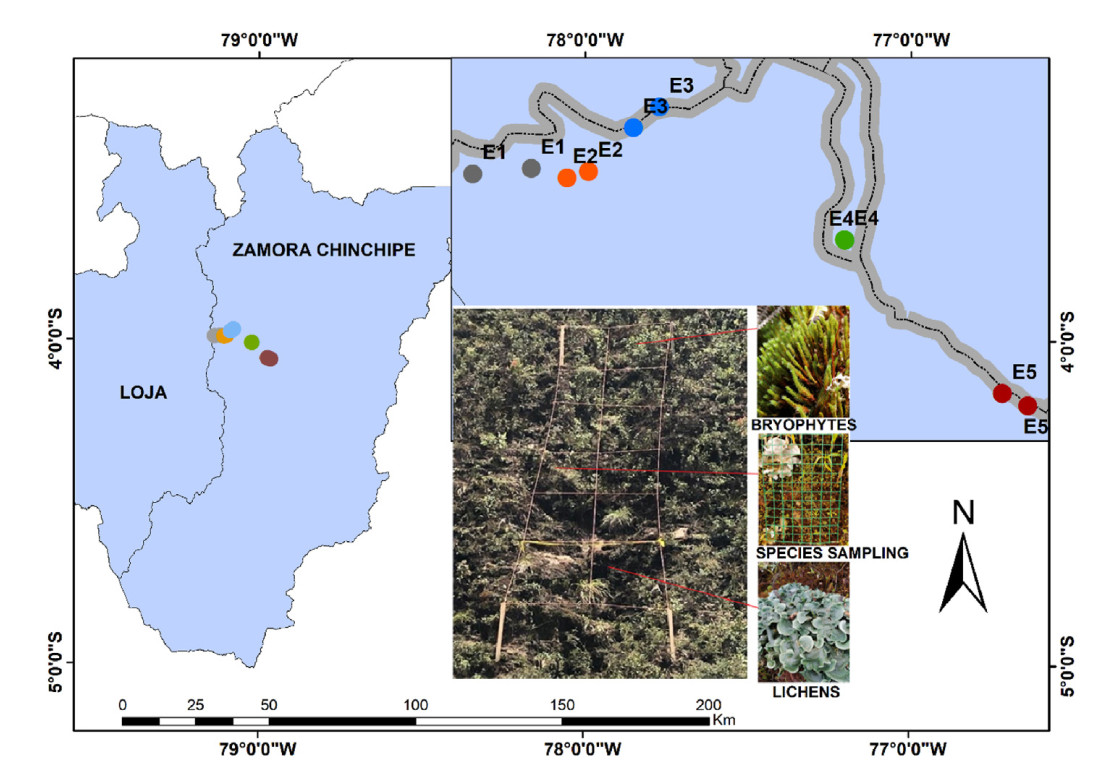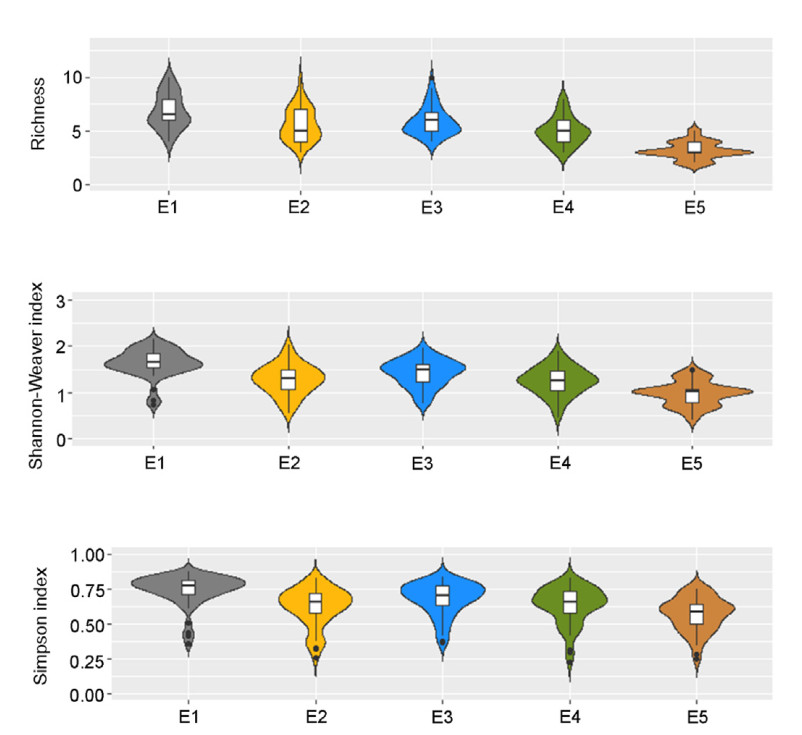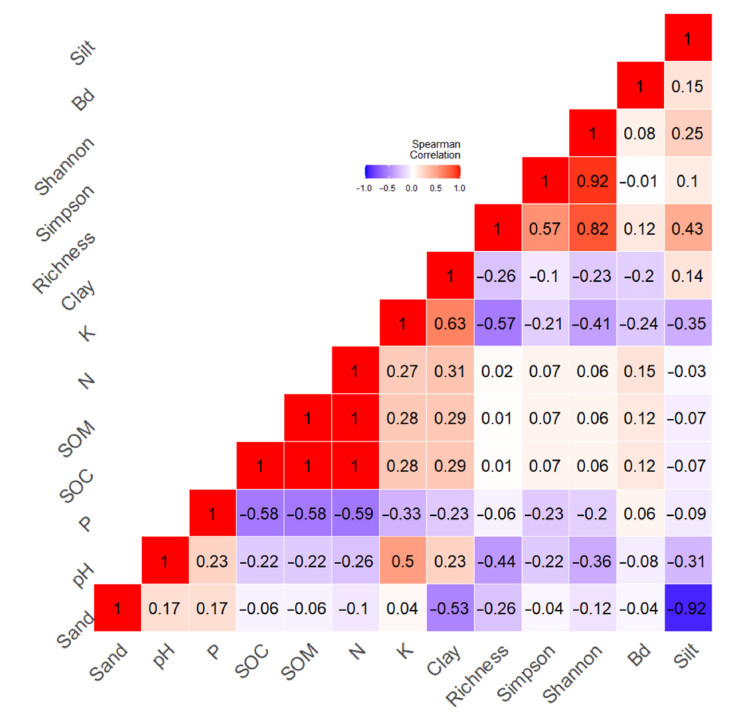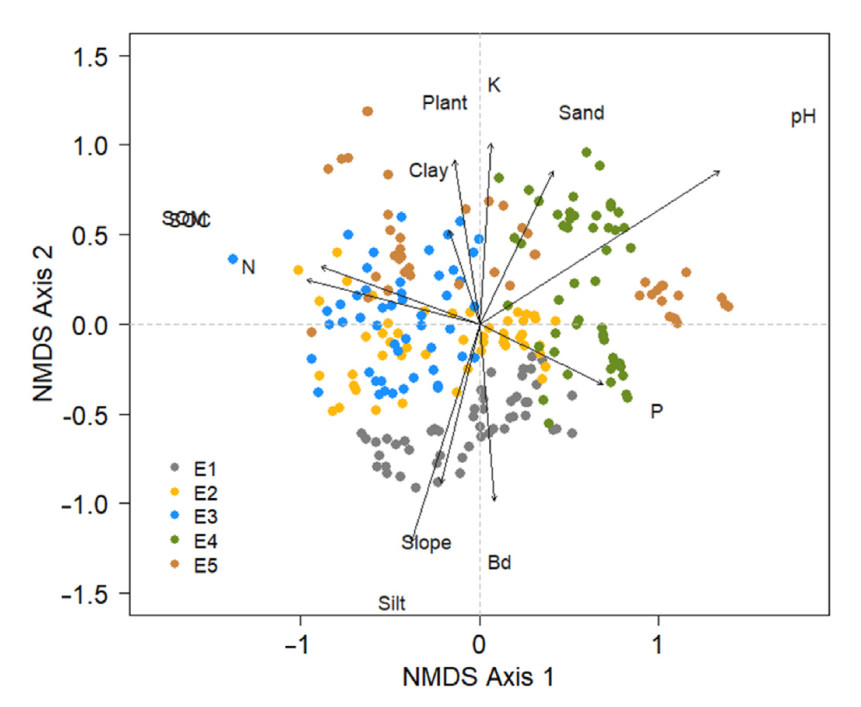| [1] |
Ahmed, S.E., Souza, C.M., Riberio, J., Ewers, R.M., 2013. Temporal patterns of roadnetwork development in the Brazilian Amazon. Reg. Environ. Change. 13, 927-937. .
|
| [2] |
Ah-Peng, C., Chuah-Petiot, M., Descamps-Julien, B., Bardat, J., Stamenoff, P., Strasberg, D., 2007. Bryophyte diversity and distribution along an altitudinal gradient on a lava flow in La Réunion. Divers. Distrib. 13, 654-662. .
|
| [3] |
Antoninka, A., Faist, A., Rodriguez-Caballero, E., Young, K.E., Chaudhary, V.B., Condon, L.A., Pyke, D.A., 2020. Biological soil crusts in ecological restoration: Emerging research and perspectives. Restor. Ecol. 28, 3-8. .
|
| [4] |
Arenas, JM., Lázaro-Lobo., A., Mola, I., Escudero, A., Casado, M.A., 2017. The influence of site factors and proximity of adjacent vegetation on tree regeneration into roadslopes. Ecol. Eng. 101, 120-129, .
|
| [5] |
Arévalo, J.R., Delgado, J.D., Otto, R., Naranjo, A., Salas, M., Fernández-Palacios, J.M., 2005. Distribution of alien vs. native plant species in roadside communities along an altitudinal gradient in Tenerife and Gran Canaria (Canary Islands). Perspect. Plant. Ecol. Evol. Systemat. 7, 185-202. .
|
| [6] |
Atkinson, B.S., Sparkes D.L., Mooney S.J., 2009. The impact of soil structure on the establishment of winter wheat ( Triticum aestivum). Eur. J. Agron. 30, 243-257. .
|
| [7] |
Austrheim, G., 2002. Plant diversity patterns in semi-natural grasslands along an elevational gradient in southern Norway. Plant. Ecol. 161, 193-205. .
|
| [8] |
Bacaro, G., Maccherini, S., Chiarucci, A., Jentsch, A., Rocchini, D., Torri, D., Gioria, M., Tordoni, E., Martellos, S., Altobelli, A., Otto, R., Escudero, C.G., Fernández-Lugo, S., Fernández-Palacios, J.M., Arévalo, J.R., 2015. Distributional patterns of endemic, native and alien species along a roadside elevation gradient in Tenerife, Canary Islands. Community Ecol. 16, 223-234. .
|
| [9] |
Ballesteros, M., Ayerbe, J., Casares, M., Cañadas, E.M., Lorite, J., 2017. Successful lichen translocation on disturbed gypsum areas: A test withadhesives to promote the recovery of biological soil crusts. Sci. Rep. 7, 45606.
|
| [10] |
Baraloto, C., Alverga, P., Quispe, S.B., Barnes, G., Chura, N.B., da Silva, I.B., Perz, S., 2015. Effects of road infrastructure on forest value across a tri-national Amazonian frontier. Biol. Conserv. 191, 674-681. .
|
| [11] |
Benítez, Á., Gradstein, S.R., Cevallos, P., Medina, J., Aguirre, N., 2019. Terrestrial bryophyte communities in relation to climatic and topographic factors in a paramo of southern Ecuador. Caldasia, 41, 370-379. .
|
| [12] |
Bernal, R., Gradstein, S. R., Celis, M.E., 2016. Catalogue of the plants and lichens of Colombia. Universidad Nacional de Colombia, Bogotá, Colombia.
|
| [13] |
Bernes, C., Bullock, J. M., Jakobsson, S., Rundlöf, M., Verheyen, K., Lindborg, R., 2017. How are biodiversity and dispersal of species affected by the management of roadsides? A systematic map. Environ. Evid. 6, 1-16. .
|
| [14] |
Black, C.A., Evans, D.D., White, J.L., Ensminger, L.E., Clark, F.E., 1965. Methods of Soil Analysis. Part-Ⅰ and Ⅱ, American Society of Agronomy, Madison, Wis, USA, p. 1572.
|
| [15] |
Bremner, J.M., 1966. Nitrogen total. In: Spark DL, editor. Methods of soil analysis, part 3: chemical methods. Wisconsin, USA. SSSA. pp. 1085-1121.
|
| [16] |
Bruun, H.H., Moen, J., Virtanen, R., Grytnes, J. A., Oksanen, L., Angerbjörn, A., 2006. Effects of altitude and topography on species richness of vascular plants, bryophytes and lichens in alpine communities. J. Veg. Sci. 17, 37-46. .
|
| [17] |
Bates, D., Machler, M., Bolker, B., Walker, S., 2014. Fitting linear mixed-effects models using lme4. arXiv 1406.5823.
|
| [18] |
Bolker, B.M., Brooks, M.E., Clark, C.J., Geange, S.W., Poulsen, J.R., Stevens, M.H.H., White, J.S.S., 2009. Generalized linear mixed models: A practical guide for ecology and evolution. Trends Ecol. Evol. 24, 127-135.
|
| [19] |
Castillo-Monroy, A.P., Benítez, Á., Reyes-Bueno, F., Donoso, D.A., Cueva, A., 2016. Biocrust structure responds to soil variables along a tropical scrubland elevation gradient. J. Arid. Environ. 124, 31-38. .
|
| [20] |
Castillo-Monroy, A.P., Benítez, Á., 2015. Patrones de abundancia y riqueza de componentes de la costra biológica del suelo en un matorral seco del sur de Ecuador. Av. Cienc. Ing. 7, 88-97. .
|
| [21] |
Churchill, S.P., Linares, E.L., 1995. Prodomus Bryologie Novo Granatensis. Introduccion a la flora de musgos de Colombia; Tomos Ⅰ y Ⅱ. Instituto de Ciencias Naturales, Facultad de Ciencias, Universidad Nacional de Colombia: Bogota.
|
| [22] |
Coffin, A.W., 2007. From roadkill to road ecology: a review of the ecological effects of roads. J. Transport. Geogr. 15, 396-406. .
|
| [23] |
Concostrina-Zubiri, L., Arenas, J.M., Martínez, I., Escudero, A., 2019. Unassisted establishment of biological soil crusts on dryland road slopes. Ecology 19, 39-51. .
|
| [24] |
Concostrina-Zubiri, L., Huber-Sannwald, E., Martínez, I., Flores, J.L., Escudero, A., 2013. Biological soil crusts greatly contribute to small-scale soil heterogeneity along a grazing gradient. Soil. Biol. Biochem. 64, 28-36.
|
| [25] |
Danin, A., Bar-Or, Y., Dor, I., Yisraeli, T., 1989. The role of cyanobacteria in stabilizing of sand dunes in southern Israel. Ecol. Mediterr. 15, 55-64. .
|
| [26] |
Deckers, B., Becker, P., De Honnay, O., Hermy, M., Muys, B., 2005. Sunken roads as habitats for woodland plant species in a dynamic agricultural landscape: effects of age and isolation. J. Biogeogr. 32, 99-109. .
|
| [27] |
Déleg, J., Gradstein, S. R., Aragón, G., Giordani, P., Benítez, Á., 2021. Cryptogamic epiphytes as indicators of successional changes in megadiverse lowland rain forests of western Amazonia. Ecol. Indicat. 129, 1-13.
|
| [28] |
Dufrêne, M., Legendre, P., 1997. Species assemblages and indicator species: the need for a flexible asymmetrical approach. Ecol. Monogr. 67, 345-366.
|
| [29] |
Dupré, C., Ehrlén J., 2002. Habitat configuration, species traits and plant distributions. J. Ecol. 90, 769-805. .
|
| [30] |
Evans, R.D., Ehleringer, J.R., 1993. A break in the nitrogen cycle in aridlands? Evidence from δ p15N of soils. Oecologia 94, 314-317. .
|
| [31] |
Fearnside, P.M., 2005. Deforestation in Brazilian Amazonia: history, rates, and consequences. Conserv. Biol. 19, 680-688. .
|
| [32] |
Fekete, R., Nagy, T., Bódis, J., Biró, É., Löki, V., Süveges, K., Molnár, A., 2017. Roadside verges as habitats for endangered lizard-orchids (Himantoglossum spp. ): Ecological traps or refuges? Sci. Total. Environ. 607, 1001-1008.
|
| [33] |
Fekete, R., Bódis, J., Fülöp, B., Süveges, K., Urgyán, R., Malkócs, T., Molnár V.A., 2020. Roadsides provide refuge for orchids: characteristic of the surrounding landscape. Ecol. Evol. 10, 13236-13247. .
|
| [34] |
Forman, R.T., Lauren, E. A, 1998. Roads and their major ecological effects. Annu. Rev. Ecol. Systemat. 29, 207-231.
|
| [35] |
García-Carmona, M., Arcenegui, V., García-Orenes, F., Mataix-Solera, J., 2020. The role of mosses in soil stability, fertility and microbiology six years after a post-fire salvage logging management. J. Environ. Manag. 262, 110287. .
|
| [36] |
García-Palacios, P., Bowker, M.A., Maestre, F.T., Soliveres, S., Valladares, F., Papadopoulos, J., Escudero, A., 2011. Ecosystem development in roadside grasslands: biotic control, plant-soil interactions, and dispersal limitations. Ecol. Appl. 21, 2806-2821. .
|
| [37] |
Gignac, L.D., Dale, M.R., 2005. Effects of fragment size and habitat heterogeneity on cryptogam diversity in the low-boreal forest of western Canada. Bryologist 108(1), 50-66.
|
| [38] |
Gordon C., Wynn J.M., Woodin S.J., 2001. Impacts of increased nitrogen supply on high Arctic heath: the importance of bryophytes and phosphorus availability. New Phytol. 149, 461-471. .
|
| [39] |
Gradstein, S.R., Costa, D.P., 2003. The Hepaticae and Anthocerotae of Brazil. Memoir. N. Y. Bot. Gard. 87, 318.
|
| [40] |
Gradstein, S.R., 2021. The Liverworts and Hornworts of Colombia and Ecuador. New York Botanical Garden, Bronx, NY, USA.
|
| [41] |
Groeneveld, E.V., Masse, A., Rochefort, L. 2007. Polytrichum strictum as a nurse-plant in peatland restoration. Restor. Ecol. 15, 709-719. .
|
| [42] |
Gunther, A.J., 1989. Nitrogen-fixation by lichens in a subarctic Alaskan watershed. Bryologist 92, 202-208. .
|
| [43] |
Guzmán, P., Benítez, Á., Carrión-Paladines, V., Salinas, P., Cumbicus, N., 2022. Elevation and Soil Properties Determine Community Composition, but Not Vascular Plant Richness in Tropical Andean Roadside. Forests 13(5), 685.
|
| [44] |
Haider, S., Kueffer, C., Bruelheide, H., Seipel, T., Alexander, J.M., Rew, L.J., Arévalo, J.R., Cavieres, L.A., McDougall, K.L., Milbau, A., Naylor, B.J., Speziale, K., Pauchard, A., 2018. Mountain roads and non-native species modify elevational patterns of plant diversity. Global Ecol. Biogeogr. 27, 667-678. .
|
| [45] |
Hawkes, C.V., 2004. Effects of biological soil crusts on seed germination of four endangered herbs in a xeric Florida shrubland during drought. Plant Ecol. 170, 121-134. .
|
| [46] |
Hijmans, R.J., Cameron, S.E., Parra, J.L., Jones, P.G., Jarvis, A., 2005. Very high resolution interpolated climate surfaces for global land areas. Int. J. Climatol. 25, 1965-1978. .
|
| [47] |
Holz, I., Gradstein, R.S., 2005. Cryptogamic epiphytes in primary and recovering upper montane oak forests of Costa Rica-species richness, community composition and ecology. Plant Ecol. 178(1), 89-109.
|
| [48] |
Hugron, S., Poulin, M., Rochefort, L., 2013. Organic matter amendment enhances establishment of reintroduced bryophytes and lichens in borrow pits located in boreal forest highlands. Boreal Environ. Res. 18, 317-328.
|
| [49] |
Issa, O. M., Le Bissonnais, Y., Défarge, C., Trichet, J., 2001. Role of a cyanobacterial cover on structural stability of sandy soils in the Sahelian part of western Niger. Geoderma 101, 15-30. .
|
| [50] |
Jackson, S.T., Hobbs, R.J., 2009. Ecological restoration in the light of ecological history. Science, 325, 567-569. https://https://doi.org/10.1126 / science. 325, 567-569.
|
| [51] |
Kidron, G.J., Vonshak, A., Abeliovich, A., 2008. Recovery rates ofmicrobiotic crusts within a dune ecosystem in the Negev Desert. Geomorphology 100, 444-452. .
|
| [52] |
Lamb, D., Erskine, P.D., Parrotta, J.A., 2005. Restoration of degraded tropical forest landscapes. Science, 310, 1628-1632. https://https://doi.org/10.1126 / science.1111773.
|
| [53] |
Lan, S., Wu, L., Zhang, D., Hu, C., 2015. Analysis of environmental factors determining development and succession in biological soil crusts. Sci. Total. Environ. 538, 492-499. .
|
| [54] |
Lange, O.L., Meyer, A., Zellner, H., Heber, U., 1994. Photosynthesis and water relations of lichen soil crusts: field measurements in the coastal fog zone of the Namib desert. Funct. Ecol. 8, 253-264. .
|
| [55] |
Laurance, W.F., Goosem, M., Laurance, S.G., 2009. Impacts of roads and linear clearings on tropical forests. Trends. Ecol. Evol. 24, 659-669. .
|
| [56] |
Lázaro-Lobo, A., Ervin, G.N., 2019. A global examination on the differential impacts of roadsides on native vs. exotic and weedy plant species. Glob. Ecol. Conserv. 17, e00555. .
|
| [57] |
Lembrechts, J. J, Milbau, A, Nijs, I., 2014. Alien roadside species more easily invade alpine than lowland plant communities in a subarctic mountain ecosystem. PLoS One 9, e89664. .
|
| [58] |
Li, X.R., Wang, X.P., Li, T., Zhang, J.G., 2002. Microbiotic soil crust and its effect on vegetation and habitat on artificially stabilized desert dunes in Tengger Desert, North China. Biol. Fertil. Soils. 35, 147-154. .
|
| [59] |
Löbel, S., Dengler, J., Hobohm, C., 2016. Species richness of vascular plants, bryophytes and lichens in dry grasslands: The effects of environment, landscape structure and competition. Folia. Geobot. 41, 377-393. .
|
| [60] |
Lorite, J., Agea, D., García-Robles, H., Cañadas, E.M., Rams, S., Sánchez-Castillo, P., 2020. Plant recovery techniques do not ensure biological soil-crust recovery after gypsum quarrying: a call for active restoration. Restor. Ecol. 28, 86-95. .
|
| [61] |
Lücking, R., Dal-Forno, M., Lawrey, J. D., Bungartz, F., Rojas, M.E., Hernandez, J.E.M., Marcelli, M.P., Moncada, B., Morales, E.A., Nelson, M.P., Paz. E, Salcedo, L., Spielmann, A.A., Wilk, K., Will-Wolf, S., Yanez, A., 2013. Ten new species of lichenized Basidiomycota in the genera Dictyonema and Cora (Agaricales: Hygrophoraceae), with a key to all accepted genera and species in the Dictyonema clade. Phytotaxa, 139, 1-38. .
|
| [62] |
Magurran, A.E., 2004. Measuring biological diversity. Biological diversity: frontiers in measurement and assessment. Wiley-Blackwell, Oxford, p. 105.
|
| [63] |
Maynard, R.J., Aall, N.C., Saenz, D., Hamilton, P.S., Kwiatkowski, M.A., 2016. Road-edge effects on herpetofauna in a lowland Amazonian rainforest. Trop. Conserv. Sci. 9, 264-290. .
|
| [64] |
Ministerio del Ambiente del Ecuador, 2013. Sistema de clasificacion de los ecosistemas del Ecuador continental. .
|
| [65] |
Monteiro, J., Brilhante, M., Domingues, I., Amaro, R., Gonçalves, D., Cavaco, T., Branquinho, C., 2020. A tale of two green walls: a functional trait approach to assess vegetation establishment on restored steep slopes. Restor. Ecol. 28, 687-696. .
|
| [66] |
Munkholm, L.J., Schjønning, P., Kay, B.D., 2002. Tensile strength of soil cores in relation to aggregate strength, soil fragmentation and pore characteristics. Soil Till. Res. 64, 125-135. .
|
| [67] |
Oksanen, J., Blanchet, F.G., Kindt, R., Legendre, P., Minchin, P.R., O'Hara, R.B., Simpson, G.L., Solymos, P., Stevens, M.H.H., Wagner, H., 2019. Vegan: Community Ecology Package version 2.5-6). .
|
| [68] |
Oldén, A., Raatikainen, K.J., Tervonen, K., Halme, P., 2016. Grazing and soil pH are biodiversity drivers of vascular plants and bryophytes in boreal wood-pastures. Agric. Ecosyst. Environ. 222, 171-184. .
|
| [69] |
Page, A.L., Miller, R.H., Keeney, D.R., 1982. Methods of soil analysis, part Ⅱ. American Society of Agronomy, Madison, WI.
|
| [70] |
Perz, S.G., Caldas, M.M., Arima, E.Y., Walker, R.T., 2007. Socio-spatial processes of unofficial road-buildingin the Amazon: socioeconomic and biophysical expla-nations. Dev. Change 38, 529-551. .
|
| [71] |
Ponzetti, J.M., McCune, B.P., 2001. Biotic soil crusts of Oregon's shrub steppe: community composition in relation to soil chemistry, climate, and livestock activity. Bryologist. 104, 212-225.
|
| [72] |
Pouliot, R., Rochefort, L., Gauthier, G., 2009. Moss carpets constrain the fertilizing effects of herbivores on graminoid plants in arctic polygon fens. Botany 87, 1209-1222. .
|
| [73] |
Qian, H., Klinka, K., Song, X., 1999. Cryptogams on decaying wood in old-growth forests of southern coastal British Columbia. J. Veg. Sci. 10(6), 883-894.
|
| [74] |
R Core Team, 2015. R: A language and environment for statistical computing. Vienna, Austria: R Foundation for Statistical Computing.
|
| [75] |
Roberts, D.W. 2013. Package 'labdsv': Ordination and Multivariate Analysis for Ecology. version 1.6-1. .
|
| [76] |
Rosentreter, R., 2020. Biocrust lichen and moss species most suitable for restoration projects. Restor. Ecol. 28, S67-S74. .
|
| [77] |
Söderström, L., Hagborg, A., Von Konrat, M., Bartholomew-Began, S., Bell, D., Briscoe, L., Zhu, R.L., 2016. World checklist of hornworts and liverworts. PhytoKeys 59, 1–828. .
|
| [78] |
Sottocornola, M., Boudreau, S., Rochefort, L., 2007. Peat bog restoration: effect of phosphorus on plant re-stablishment. Ecol. Eng. 31, 29-40. .
|
| [79] |
Szczepanika K., Biziuk M., 2003. Aspects of biomonitoring studies using mosses and lichens as indicators of metal pollution. Environ. Res. 93, 221-230.
|
| [80] |
Tan, D., Jin, J., Jiang, L., Huang, S., Liu, Z., 2012. Potassium assessment of grain producing soils in North China. Agric. Ecosyst. Environ. 148, 65-71. .
|
| [81] |
Tavili, A., Jafari, M., Chahouki, M.A.Z., Sohrabi, M., 2017. How do cryptogams affect vascular plant establishment? Cryptogam Bryol. 38(3), 313-323.
|
| [82] |
Van Diggelen, R., Grootjans, A.P., Harris, J.A., 2001. Ecological restoration: state of the art or state of the science? Restor. Ecol. 9(2), 115-118.
|
| [83] |
Vittoz, P., Camenisch, M., Mayor, R., Miserere, L., Vust, M., Theurillat, J.P., 2010. Subalpine-nival gradient of species richness for vascular plants, bryophytes and lichens in the Swiss Inner Alps. Bot. Helv., 120(2), 139-149.
|
| [84] |
Wallace, K.J., 2007. Classification of ecosystem services: problems and solutions. Biol. Conserv. 139(3-4), 235-246.
|
| [85] |
Wentink, C., 2015. Landscape restoration: new directions in global governance. Netherlands Environmental Assessment Agency, The Hague, the Netherlands.
|
| [86] |
Zhang Y.M., Nie H.L., 2011. Effects of biological soil crusts on seedling growth and element uptake in five desert plants in Jungar Basin, Western China. Chin. J. Plant Ecol. 35, 380-388.
|



 DownLoad:
DownLoad:









 Email Alerts
Email Alerts RSS Feeds
RSS Feeds